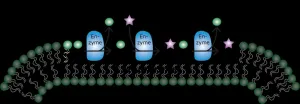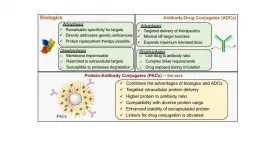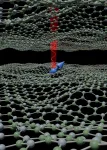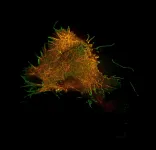In the Alps, climate change affects biodiversity
2021-05-06
(Press-News.org) The European Alps is certainly one of the most scrutinized mountain range in the world, as it forms a true open-air laboratory showing how climate change affects biodiversity. Although many studies have independently demonstrated the impact of climate change in the Alps on either the seasonal activity (i.e. phenology) or the migration of plants and animals, no systematic analysis has been carried out on both consequences simultaneously. A European team of ecologists1, including Jonathan Lenoir, CNRS Researcher in the research unit Écologie et Dynamique des Systèmes Anthropisés (CNRS/University of Picardie Jules Verne), has just published a review that quantifies seasonal changes and elevational movements of more than 2,000 species of plants, animals and fungi that live in the Alps. This review shows that species have shifted their life cycles (e.g. bud burst for plants or nesting for birds) earlier during the season2 and their distribution higher along the elevational gradient, but that the average velocity of range shift3, which varies from species to species, is often lagging behind the velocity of climate change. These results, partly based on citizen science data, were published online on 27 April 2021 in Biological Reviews.
Notes:
1 The laboratories: WSL Swiss Federal Institute for Forest, Snow and Landscape Research, Department of Environmental Sciences (University of Basel, Switzerland), Institute of Geography (University of Neuchâtel, Switzerland), Centre de Recherches sur les Ecosystèmes d'Altitude (Chamonix Mont-Blanc, France), le Laboratoire d'écologie alpine ( CNRS/Université Grenoble Alpes/Université Savoie Mont Blanc), WSL Institute for Snow and Avalanche Research, Schweizerische Vogelwarte, Institut für Evolutionsbiologie und Umweltwissenschaften (Universität Zürich, Switzerland), Swiss National Park (Zernez, Switzerland), Department of Arctic and Marine Biology (UiT The Arctic University of Norway, Norway).
2 While terrestrial insects, reptiles, migratory birds, and plants have reacted strongly to global warming by advancing their spring activity by an average of 2 to 8 days per decade, other groups of organisms such as nesting birds, amphibians, and aquatic insects have shifted their spring activity less or not at all.
3 Significant changes in mean elevation distribution were found for butterflies, reptiles, trees and shrubs (more than +30 m/decade), while certain groups such as semi-aquatic insects having an aquatic larval stage or birds, ferns and alpine plants only migrated a little in elevation (less than+ 15 m/decade).
INFORMATION:
ELSE PRESS RELEASES FROM THIS DATE:
2021-05-06
Cells of all life forms are surrounded by a membrane that is made of phospholipids. One of these are the cardiolipins, which form a separate class due to their unique structure. When studying the enzyme that is responsible for producing cardiolipins in archaea (single-cell organisms that constitute a separate domain of life), biochemists at the University of Groningen made a surprising discovery. A single archaeal enzyme can produce a spectacular range of natural and non-natural cardiolipins, as well as other phospholipids. The results, which show potential for biotechnological applications, ...
2021-05-06
Lessons Learned from India's Polio Vaccination Program Provide Valuable Insights for Future Mass Vaccination Initiatives.
Toronto - As India urgently scales up its vaccination campaign for the COVID-19 virus, a new study which examined the country's successful program to eliminate polio provides guidance on how this and future mass immunization campaigns can be successful, especially in vaccinating hard to reach groups.
The study, conducted by students and faculty with the Reach Alliance, a research initiative based at the University of Toronto's Munk School of Global Affairs & Public Policy, says that medicine alone is insufficient for the elimination of disease.
The World Health Organization declared India polio-free in 2014. ...
2021-05-06
AMHERST, Mass. - A team of researchers at the Center for Bioactive Delivery at the University of Massachusetts Amherst's Institute for Applied Life Sciences has engineered a nanoparticle that has the potential to revolutionize disease treatment, including for cancer. This new research, which appears today in Angewandte Chemie, combines two different approaches to more precisely and effectively deliver treatment to the specific cells affected by cancer.
Two of the most promising new treatments involve delivery of cancer-fighting drugs via biologics or antibody-drug conjugates (ADCs). Each has its own advantages and limitations. Biologics, such as protein-based ...
2021-05-06
May 6, 2021 -- A significant level of symptoms of depression, anxiety and post-traumatic stress may follow COVID-19 independent of any previous psychiatric diagnoses, according to new research by Columbia University Mailman School of Public Health with colleagues at Universidade Municipal de São Caetano do Sul in Brazil. Exposure to increased symptomatic levels of COVID-19 may be associated with psychiatric symptoms after the acute phase of the disease. This is the largest study to evaluate depressive, anxiety, and post-traumatic stress symptoms in tandem among patients who had mild COVID-19 ...
2021-05-06
Quantum computers or quantum sensors consist of materials that are completely different to their classic predecessors. These materials are faced with the challenge of combining contradicting properties that quantum technologies entail, as for example good accessibility of quantum bits with maximum shielding from environmental influences. In this regard, so-called two-dimensional materials, which only consist of a single layer of atoms, are particularly promising.
Researchers at the new Center for Applied Quantum Technologies and the 3rd Institute of Physics at the University of Stuttgart have now succeeded in identifying promising quantum bits in these materials. They were able to show that the quantum bits can be generated, read out and coherently controlled in a very ...
2021-05-06
The Marburg virus, a relative of the Ebola virus, causes a serious, often-fatal hemorrhagic fever. Transmitted by the African fruit bat and by direct human-to-human contact, Marburg virus disease currently has no approved vaccine or antivirals to prevent or treat it.
A team of researchers is working to change that. In a new paper in the journal Antimicrobial Agents and Chemotherapy, investigators from Penn's School of Veterinary Medicine, working together with scientists from the Fox Chase Chemical Diversity Center and the Texas Biomedical Research Institute, report encouraging results from tests of an experimental ...
2021-05-06
WASHINGTON -- Researchers have demonstrated a record-high laser pulse intensity of over 1023 W/cm2 using the petawatt laser at the Center for Relativistic Laser Science (CoReLS), Institute for Basic Science in the Republic of Korea. It took more than a decade to reach this laser intensity, which is ten times that reported by a team at the University of Michigan in 2004. These ultrahigh intensity light pulses will enable exploration of complex interactions between light and matter in ways not possible before.
The powerful laser can be used to examine phenomena believed to be responsible for ...
2021-05-06
Recently, laser scientists at the Center for Relativistic Laser Science (CoReLS) within the Institute for Basic Science (IBS) in South Korea realized the unprecedented laser intensity of 1023 W/cm2. This has been a milestone that has been pursued for almost two decades by many laser institutes around the world.
An ultrahigh intensity laser is an important research tool in several fields of science, including those which explore novel physical phenomena occurring under extreme physical conditions. Since the demonstration of the 1022 W/cm2 intensity laser by a team at the ...
2021-05-06
The health benefits of sardines and oily fish are widely known: their high levels of unsaturated fats help to regulate cholesterol levels and prevent the onset of cardiovascular diseases. However, the benefits don't end there. A study led by Diana Diaz Rizzolo, lecturer and researcher of the Universitat Oberta de Catalunya's (UOC) Faculty of Health Sciences and the August Pi i Sunyer Biomedical Research Institute (IDIBAPS), has discovered that the regular consumption of sardines helps to prevent the onset of type 2 diabetes. Nutrients found in high quantities in sardines - such as taurine, omega 3, calcium and vitamin D - help to protect against this disease which, according to CIBERDEM's Di@betes study, affects around 14% of the Spanish population over the ...
2021-05-06
The published data provide additional detail of an initial analysis conducted in January, while more robust data from a complete analysis of the study was subsequently shared in March 2021.
Publication of initial primary analysis highlights cross-protection by the Novavax Covid-19 vaccine against the B.1.351 variant prevalent in South Africa during the study.
This is the first published study to show protection against mild Covid-19 caused by the B.1.351 variant circulating in South Africa.
An updated analysis of the study indicated 100% protection against severe Covid-19 due to the B.1.351 variant.
"An efficacy of 50% is sufficient to meet the World ...
LAST 30 PRESS RELEASES:
[Press-News.org] In the Alps, climate change affects biodiversity







